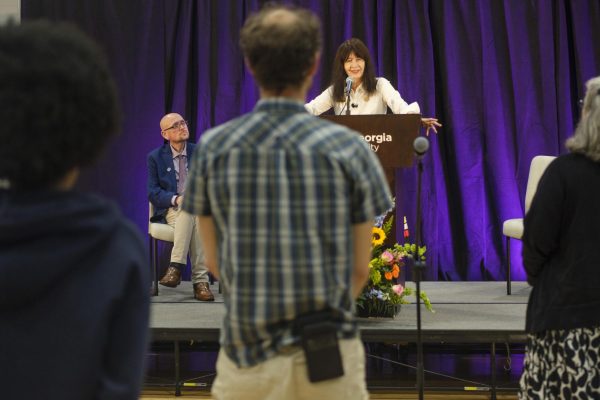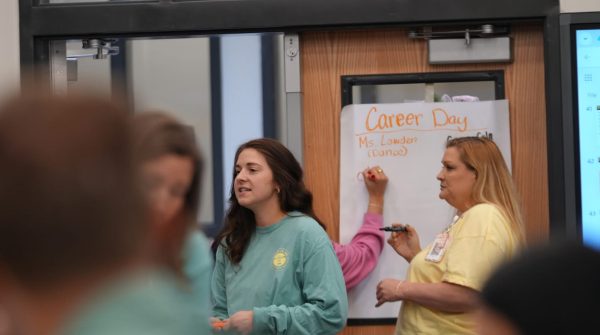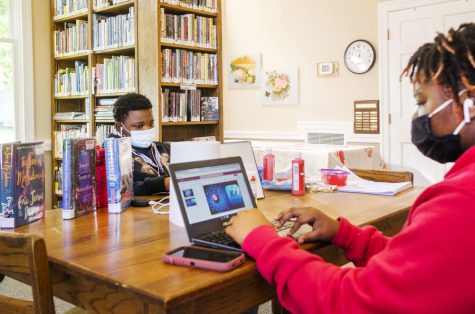Taking the Virtual World into 2021 and Beyond
Technology experts have found that the 2020 pandemic actually pushed this new virtual world into “hyperdrive.” Zoom business meetings, laptop classrooms, Telehealth and even virtual Santa visits are all part of the new normal.
Jerome Gratigny, Mercer University Director of Academic Technology Services, said this new virtual world is here to stay. He likened it to the idea of not going back to the horse and wagon after being introduced to automobiles and planes.
“Pandora’s box has already been opened, and we’re not gonna put the genie back into the bottle,” Gratigny said. “For example, take remote work or Zoom meetings, why would you say, ‘Okay, now we’re gonna walk over there. We’re gonna spend time. We’re gonna spend possible travel money.’ When can we just jump into a Zoom meeting? it’s cost effective. It’s fast. It’s efficient.”
He said Zoom may have been around for years but had not reached the current level of capacity until the pandemic. According to Gratigny, technology usage like video conferencing increased dramatically during the early stages of the pandemic because remote access was needed.
Gratigny also pointed to specific stats like how Mercer University’s faculty used learning technologies like Canvas. Before COVID this was used around 35%. After the pandemic and remote learning began, the usage rate increased to 100%.
Gratigny said if COVID-19 had hit us several years earlier, we may not have been ready.
“If this would have happened five or 10 years ago, we wouldn’t have had the success rate that I think people are having, and finding that you can work from home, communicate with people and life continues,” Gratigny said. “ I’ve had several Zoom meetings with my family, things like that, and keeping in communication with people on Facebook and all those kinds of things.”
Along with schools and businesses, the healthcare industry is also moving into 2021 using the available tools of the virtual world.
According to the Global Partnership for TeleHealth, Georgia patients using telehealth services doubled since the COVID-19 crisis began.
“I think that the pandemic has, as it has in so many different areas, out of necessity and need, taught us how to do things that we probably would have learned anyway, but it would have been over maybe five years to 10 years instead of five to 10 months,” said Dr. Dean Kindler, Physician in Chief and Senior Vice President for operations of the Navicent Health Physicians Group.
Prior to COVID, Navicent in partnership with Atrium, had planned an end of year rollout of several virtual programs including a one-stop, one-click Telehealth site. Using the Amwell telemedicine platform, Dr. Kindler said the site was originally planned for patients and families with mild symptoms that might require urgent care or a doctor’s visit.
“Like cold symptoms, flu symptoms, obviously all this before COVID. And all those types of symptoms like scrapes and bruises, and really being able to be available throughout the day for convenience, where you could use the virtual platform on your phone or your computer,” Kindler said.
By February and March, when COVID hit the community, Navicent was able to rapidly transition to meet the new need.
“Within 36 hours we converted many of our routine practices into a virtual setting in order to promote public safety and really keep our patients safe and, quite frankly, our staff so we can continue to provide care to the community,” Kindler said.
Using telehealth in this way also allowed for better triage and minimized the use of personal protective equipment (PPE) like masks and other types of medical protection. Kindler said this was key to safely bring in patients who really needed to be seen in person.
Along with the Virtual Visit site and the Virtual Care Delivery System, designed specifically to meet COVID-19 needs, Navicent speeded up implementation of its Virtual ICU. This telehealth program gives rural hosptial primary care providers (PCPs) 24/7 remote access to other critical care doctors. It also allows for patients to be treated at hospitals closer to home. This technology has been vital in helping patients at Navicent’s Baldwin, Monroe and Peach County hospitals.
“At neither of those did we have boots on the ground, medical intensivists that could directly assist with the care. So that platform really allowed us to provide care to critically ill patients that were not able to be transferred to other institutions. So that was a big plus,” Kindler said.
During the pandemic, Kindler said there just wasn’t capacity anywhere in the state for a number of patients to be transferred. So Virtual ICU was important.
But beyond the pandemic the hospital’s goal is to continue to provide critical care resources to patients that can be co-managed safely. Navient’s telehealth expansion includes Virtual Patient Observations and Virtual Behavioral Health. Both of these telehealth programs were started before the pandemic.
“Through the pandemic, out of necessity, has taught us many things, and also allowed us to see how these platforms could be extremely helpful in the future outside of the pandemic,” Dr Kindler said.
Virtual World Growing Pains
Of course whenever technology and people merge, Jerome Gratigny said there’s often some apprehension about learning and using new technology.
“Such as heightened anxiety sometimes when people are working with technology that there can be those heightened anxieties or they don’t understand it fully,” Gratigny said.
Gratigny said new technology adoption is always broken down into four groups.
“The early adopters are the people who are going to use the technology because it’s available. The next level are the sort of followers who watch those early adopters, to see that people are using it, and then it’s working,” Gratigny said. “Then you have the kind of the large group in the middle. And then you have the bottom group, which is the resistors,” Gratigny said.
He points out that the resistors are just not technologically inclined, and plan to resist anyway. But he said they have to fall in step in a lot of ways because they don’t want to be left out of the loop.
Outside of personal choice there is also the digital divide. This refers to a lack of communication technology, and in some cases, restricted access to technology based on region. But Gratigny said parts of Georgia can experience the digital divide if the problem of no access to high speed internet continues to go unchecked.
“Especially in rural communities, you’re going to have a lot of people who are left behind.because, for example, education. Yes, if you live in Macon, Georgia, or Atlanta, and we go virtual, that’s no big deal. But if you live in South rural Georgia, and the class goes virtual, well, you may not even have a computer in your house or you may not have high speed internet,” Gratigny said. “ And I think even if you’re going to apply for a job at Walmart, or even McDonald’s, you have to do that online too.”
Finally, there is the question of human contact, or loss of it. Even as technology may keep us more connected, Gratigny points out the irony to virtually connecting.
“It’s like, we’re more connected, I can have meetings with you over the phone, I can meet with people on Zoom from all over the world or America. But yet at the same time, I feel a little bit isolated,” Gratigny said. “And I think for many people, that isolation, in contrast with the fact that we’re purely connected at the same time, is something that we’re going to have to look at moving forward.”
Whether it’s entertainment, healthcare, school or work, Gratigny sees the virtual world as traveling on a rapid trajectory upward.
“It doesn’t matter if we fear it, or stop it, or try to curtail it, it’s going to happen,” Gratigny said.
So while it may be a little challenging, and even take time to get used to it, the virtual world will move through 2021 and beyond.









